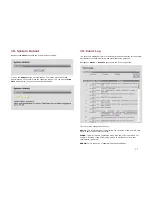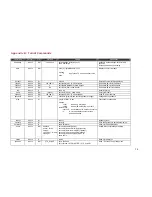
6
5. Security
Navigate to Configuration -> Security to access the Security Configuration
screen:
Three data encryption options are available: Open, AES and Radius. All units
on a wireless network must share the same security settings.
Open: Removes all encryption and formal authentication methods. Note that
even with an Open setting, there is still a MAC address based Access Control
system which provides a basic level of security. (See next section)
AES: Provides 128-bit AES data encryption with passphrase based
authentication.
Radius: In addition to AES encryption, this option adds Radius/802.1x
authentication capability compatible with all MS-CHAPv2/PEAP authentication
servers.
6. Access Control
In addition to the formal security methods detailed in the previous section, a
second, independent access control layer is available.
This Layer2 access control system requires that the Master be programmed
with the MAC address of the Slave.
Navigate to Configuration -> ACL to access the following screen:
Slave’s MAC: This is the hardware RF MAC address of the client unit in
question. This MAC address can be found on the client unit’s user interface or
on the rear label. The correct address must be used to establish an RF link with
the base.
Slave’s Description: Type in any description that will easily identify the peer
with the above MAC address. This is an optional field for your convenience only
and has no effect on the operation of the unit.
Click Add after typing in MAC address and Description. Note that the slave unit
is in the Master’s access list and is shown on the bottom half of the screen.





















